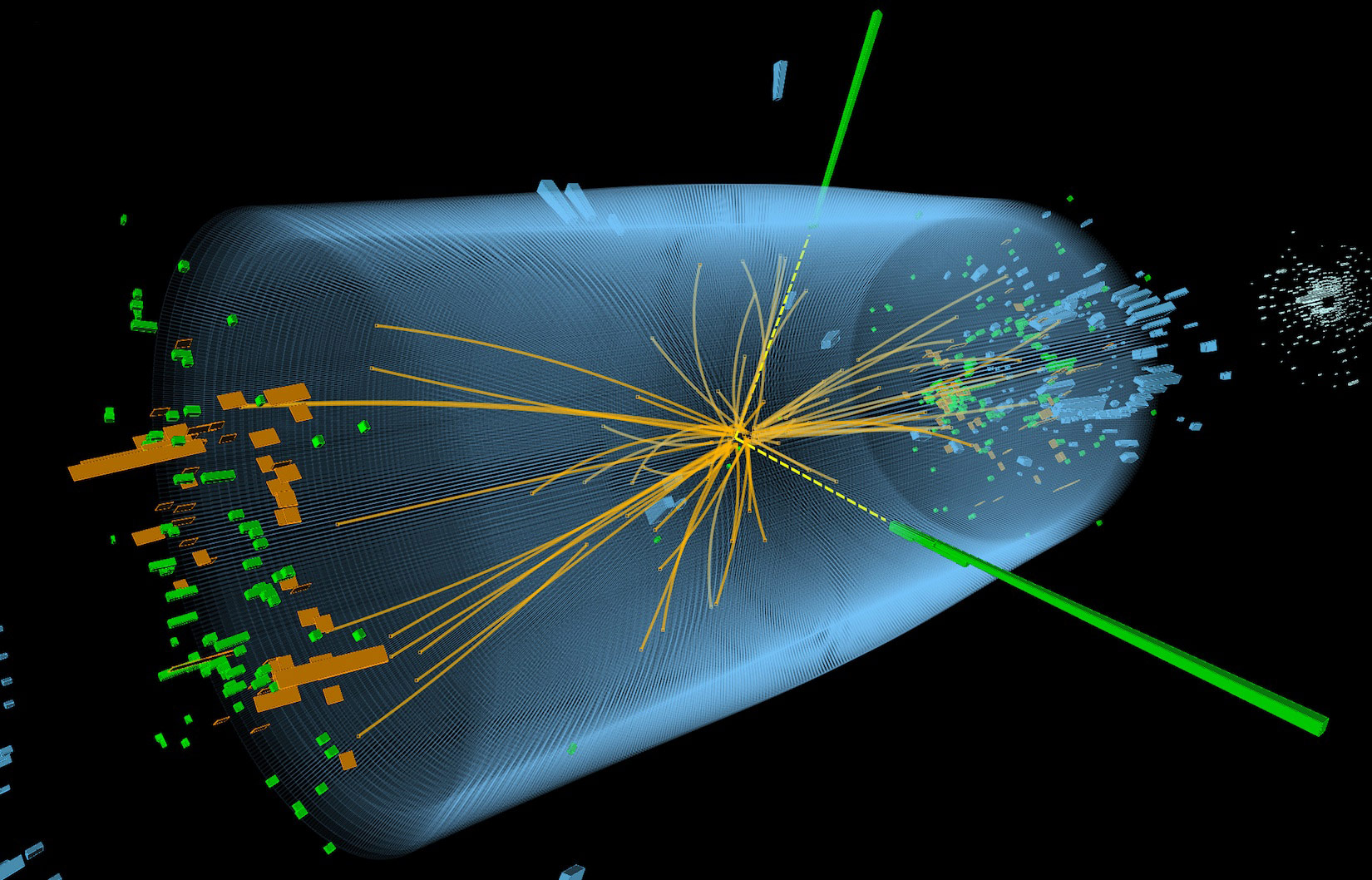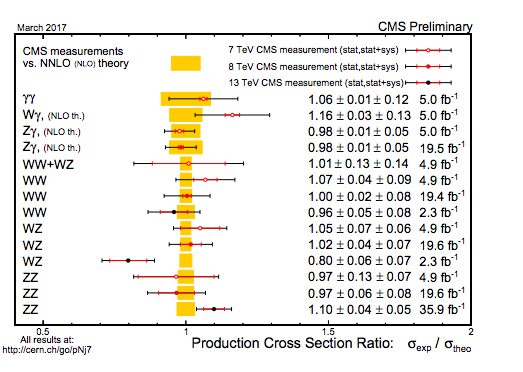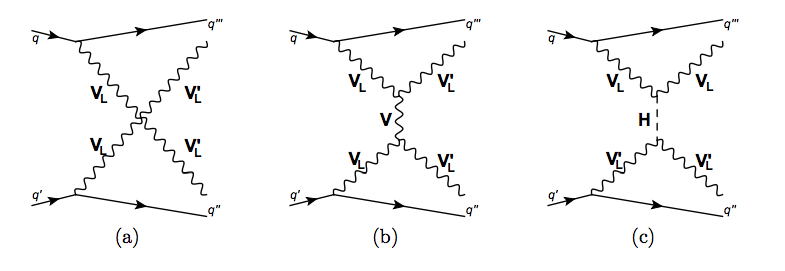Electroweak boson pairs offer new approach to searches for New Physics
During the past decades, the Standard Model (SM) of particle physics that explains how the basic building blocks of matter interact is scrutinised by high energy physics experiments. Along with the remarkable success of the SM, there are compelling reasons to consider that at higher energy scales the SM requires an extension into a more fundamental theory. However, the energy scale of New Physics might lie beyond the reach of the LHC and not be directly accessible by the experiments. Thus, probes of processes that can be indirectly affected by the new phenomena become particularly valuable. For such processes, the presence of new interactions, even at higher energy scales, could manifest at the LHC energy reach. One of the most promising channels for searches is the study of the production of electroweak (EW) boson-pairs, namely W and Z bosons and photons, through their self-interactions. New Physics effects, direct or indirect, can modify the strength of how the electroweak bosons interact with each other. Experimentally this would be observed as an enhancement of the production cross-section in the tails of distributions, such as the transverse momentum or invariant mass of a diboson system. Such searches for New Physics are based on precision measurements of diboson processes and are complementary to the direct searches of new resonances that might produce diboson final states.

The ATLAS and CMS experiments have developed comprehensive diboson physics programs to further explore this frontier. Among the most impressive recent results are the studies of ZZ production at = 13 TeV in the four lepton channel. The precision of cross section measurements has reached an unprecedented order of 5% for the diboson sector. The major components of this success are the large increase of the statistics and the excellent performance of the detectors. Among the diboson processes, ZZ production with both bosons decaying into pairs of high-pT leptons has the cleanest experimental signature, since all the final state particles are reconstructed in the detectors. However, at the same time it has the lowest production rate. For instance the ATLAS experiment, based on 36.1 fb-1 of 13 TeV data, has selected a sample of 1017 observed ZZ-candidate events with only 2% of background contamination. The increase of statistics compared to 7 and 8 TeV datasets allowed to study the kinematics of ZZ events in detail by looking into a variety of differential distributions. In particular, it permitted to make a first step towards studies of rare ZZ production through vector-boson scattering (VBS), a phenomenon that has not been experimentally observed so far. CMS has recently reported the first experimental investigation of ZZ VBS process. Based on 35.9 fb-1 of 13 TeV data, CMS measured cross section of ZZ electroweak production in association with two jets with an observed significance of 2.7 standard deviations. As a window for New Physics searches, ZZ production is particularly interesting due to the absence of interactions including three or four bosons in the SM; therefore observing any deviation from the SM predictions would indicate the presence of New Physics.


Figure 1. Ratios of several diboson total and fiducial production cross section measurements over the best theoretical prediction available.
Since the studies did not reveal any significant deviations from the SM predictions, the measurements have been used to set confidence intervals on the anomalous neutral gauge coupling parameters.
Measurements of diboson production often suffer from low statistics and one possibility to overcome this limiting factor is to consider semileptonic decays of boson pairs. Studies of channels with one boson decaying leptonically and the other hadronically allow for a compromise between the high statistics and the limited experimental precision, due to the background contamination of signal samples.
In WZ and WW (collectively denoted as WV) production the configuration with one W boson decaying leptonically and another W or Z boson decaying into hadrons has about six time higher branching ratio compared to the fully leptonic channel. The semileptonic measurements can be performed in two different ways: with two resolved jets reconstructed as separate objects as well as with two boosted jets forming as a single large-radius jet. Reconstruction of boosted jets as a single object allows to improve reconstruction efficiency for high pT bosons, which is a particularly sensitive region for New Physics searches. A recent measurement of WV production with semileptonic decay for these two topologies was performed by ATLAS using 8 TeV data.
CMS performed searches for anomalous triple gauge couplings exclusively in the boosted semileptonic WV channel using 8 and 13 TeV data. Both experiments set limits on the charged anomalous couplings, WWγ and WWZ. The results of the searches are compatible with previous diboson constraints and are consistent with the SM expectation.
The precision measurements with searches for anomalous gauge boson couplings are especially valuable for the scenario in which New Physics energy scale is beyond the LHC reach. However, for the alternative scenario in which the New Physics energy scale is reachable by the LHC, direct searches for new resonances play primary role. Many models of physics beyond the SM predict the production of new heavy resonances that subsequently decay into boson pairs. A new signal would appear in the invariant diboson mass spectrum as a bump over a smoothly decreasing SM background. Two ATLAS searches of diboson resonances based on 13 TeV data were recently released. First of them explores a mass range between 1.2 and 5 TeV for the presence of narrow resonances decaying into pairs of high-momentum bosons with subsequent hadronic decays. In this kinematic range, the decay products of each of the bosons are highly collimated and can be reconstructed as a large-radius jet with two-body substructure, corresponding to the boson decay into two quarks. The second search examines mass range between 0.3 and 5 TeV for presence of new resonances that decay into ZZ or ZW boson pairs. Z boson in these searches decay into a pair of light leptons, muons or electrons, or a pair of neutrinos. The second boson in the ZZ or ZW pair decays hadronically and can be reconstructed either as two separate jets or as one large-radius jet. The analyses results are interpreted in terms of several models that predict either a new spin-0 resonance, a spin-1 heavy triplet (W', Z') or spin-2 Kaluza-Klein excitations of the graviton. No evidence for such resonances has been observed and the analysis results are used to set exclusion limits on the production cross-section times branching ratio.
Until now, LHC results have not revealed the presence of New Physics. To extend its discovery potential, the LHC will undergo a major upgrade around 2020 targeting an increase of its luminosity to 3000 fb-1 which is by a factor of 10 larger than original design value. The higher expected luminosity implies an increased rate of pile-up interactions and radiation level. This will require several upgrades of the detectors to maintain the performance of the objects. To that end, the ATLAS and CMS detectors plan for example to extend inner tracking systems towards the forward region and increase coverage of muon detectors. In the context of diboson physics, the increase of statistics and the extension of experimentally accessible phase space will be particularly important for studies of rare electroweak vector-boson scattering processes. Searches for VBS production are actively ongoing, not only in ZZ channel that we mentioned before, but also for other combinations of EW bosons and decay channels. Only very recently the EW production of same charged W bosons with VBS processes was experimentally observed by CMS experiment at 13 TeV. Increase of the statistics will give a boost for the VBS studies. Moreover, the possibility of studying bosons with longitudinal polarisation states will be extremely valuable. The cross section for the scattering of two longitudinally polarised gauge bosons grows with the energy. This process, with only vector bosons involved, is expected to violate unitarity at the TeV energy scale (the probability for this process becomes larger than one).

Figure 2: Representative diagrams for the vector boson scattering process. In the absence of any other contributions, the amplitudes involving only electroweak bosons (V ), such as diagrams (a) and (b) would violate unitarity. In the SM the unitarity is preserved via strong interference with amplitudes that include the Higgs boson (such as in diagram (c)).
Since unitarity has to be preserved, we know that there must be a mechanism that restores it. In the calculation of the cross section one has to take into account the interaction of vector bosons with the Higgs boson which reduces probability to lower than one. Any modification of the scattering processes due to New Physics effects would alter the cancellation from SM processes. This would result in changes to the cross section at high energy scale of the interaction. Thus, VBS studies can shed light on the nature of this mechanism - whether it is only due to electroweak symmetry breaking with the SM Higgs boson or if there is also New Physics involved.
